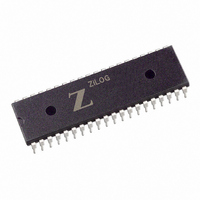Z84C0010PEG Zilog, Z84C0010PEG Datasheet - Page 32

Z84C0010PEG
Manufacturer Part Number
Z84C0010PEG
Description
IC 10MHZ Z80 CMOS CPU 40-DIP
Manufacturer
Zilog
Series
Z80r
Specifications of Z84C0010PEG
Processor Type
Z80
Features
Enhanced Z80 Microprocessor/CPU
Speed
10MHz
Voltage
5V
Mounting Type
Through Hole
Package / Case
40-DIP (0.620", 15.75mm)
Core Size
8bit
Cpu Speed
10MHz
Digital Ic Case Style
DIP
No. Of Pins
40
Operating Temperature Range
-40°C To +100°C
Svhc
No SVHC (18-Jun-2010)
Operating Temperature Max
100°C
Rohs Compliant
Yes
Processor Series
Z84C0xx
Core
Z80
Data Bus Width
8 bit
Program Memory Size
64 KB
Maximum Clock Frequency
10 MHz
Operating Supply Voltage
0 V to 5 V
Maximum Operating Temperature
+ 100 C
Mounting Style
Through Hole
Minimum Operating Temperature
- 40 C
Base Number
84
Clock Frequency
10MHz
Frequency Typ
10MHz
Lead Free Status / RoHS Status
Lead free / RoHS Compliant
Other names
269-3898
Z84C0010PEG
Z84C0010PEG
Available stocks
Company
Part Number
Manufacturer
Quantity
Price
Company:
Part Number:
Z84C0010PEG
Manufacturer:
Zilog
Quantity:
110
Company:
Part Number:
Z84C0010PEG
Manufacturer:
Zilog
Quantity:
203
Part Number:
Z84C0010PEG
Manufacturer:
ZILOG
Quantity:
20 000
- Current page: 32 of 308
- Download datasheet (2Mb)
12
UM008005-0205
Z80 CPU
User’s Manual
CLK
Instruction Fetch
T Cycle
T1
Figure 4.
Figure 5 depicts the timing during an M1 (opcode fetch) cycle. The PC is
placed on the address bus at the beginning of the M1 cycle. One half clock
cycle later the MREQ signal goes active. At this time the address to the
memory has had time to stabilize so that the falling edge of MREQ can be
used directly as a chip enable clock to dynamic memories. The RD line also
goes active to indicate that the memory read data should be enabled onto the
CPU data bus. The CPU samples the data from the memory on the data bus
with the rising edge of the clock of state T3 and this same edge is used by
the CPU to turn off the RD and MREQ signals. Thus, the data has already
been sampled by the CPU before the RD signal becomes inactive. Clock
state T3 and T4 of a fetch cycle are used to refresh dynamic memories. The
CPU uses this time to decode and execute the fetched instruction so that no
other operation could be performed at this time.
During T3 and T4, the lower seven bits of the address bus contain a memory
refresh address and the RFSH signal becomes active tindicating that a
refresh read of all dynamic memories must be accomplished. An RD signal
is not generated during refresh time to prevent data from different memory
Machine Cycle
(Opcode Fetch)
T2
M1
Basic CPU Timing Example
T3
Instruction Cycle
T1
(Memory Read)
M2
T2
T3
T1
(Memory Write)
M3
T2
T3
Overview
Related parts for Z84C0010PEG
Image
Part Number
Description
Manufacturer
Datasheet
Request
R

Part Number:
Description:
Kio Serial/parallel Counter Timer
Manufacturer:
ZiLOG Semiconductor
Datasheet:

Part Number:
Description:
Communication Controllers, ZILOG INTELLIGENT PERIPHERAL CONTROLLER (ZIP)
Manufacturer:
Zilog, Inc.
Datasheet:

Part Number:
Description:
KIT DEV FOR Z8 ENCORE 16K TO 64K
Manufacturer:
Zilog
Datasheet:

Part Number:
Description:
KIT DEV Z8 ENCORE XP 28-PIN
Manufacturer:
Zilog
Datasheet:

Part Number:
Description:
DEV KIT FOR Z8 ENCORE 8K/4K
Manufacturer:
Zilog
Datasheet:

Part Number:
Description:
KIT DEV Z8 ENCORE XP 28-PIN
Manufacturer:
Zilog
Datasheet:

Part Number:
Description:
DEV KIT FOR Z8 ENCORE 4K TO 8K
Manufacturer:
Zilog
Datasheet:

Part Number:
Description:
CMOS Z8 microcontroller. ROM 16 Kbytes, RAM 256 bytes, speed 16 MHz, 32 lines I/O, 3.0V to 5.5V
Manufacturer:
Zilog, Inc.
Datasheet:

Part Number:
Description:
Low-cost microcontroller. 512 bytes ROM, 61 bytes RAM, 8 MHz
Manufacturer:
Zilog, Inc.
Datasheet:

Part Number:
Description:
Z8 4K OTP Microcontroller
Manufacturer:
Zilog, Inc.
Datasheet:

Part Number:
Description:
CMOS SUPER8 ROMLESS MCU
Manufacturer:
Zilog, Inc.
Datasheet:

Part Number:
Description:
SL1866 CMOSZ8 OTP Microcontroller
Manufacturer:
Zilog, Inc.
Datasheet:

Part Number:
Description:
SL1866 CMOSZ8 OTP Microcontroller
Manufacturer:
Zilog, Inc.
Datasheet:

Part Number:
Description:
OTP (KB) = 1, RAM = 125, Speed = 12, I/O = 14, 8-bit Timers = 2, Comm Interfaces Other Features = Por, LV Protect, Voltage = 4.5-5.5V
Manufacturer:
Zilog, Inc.
Datasheet:











